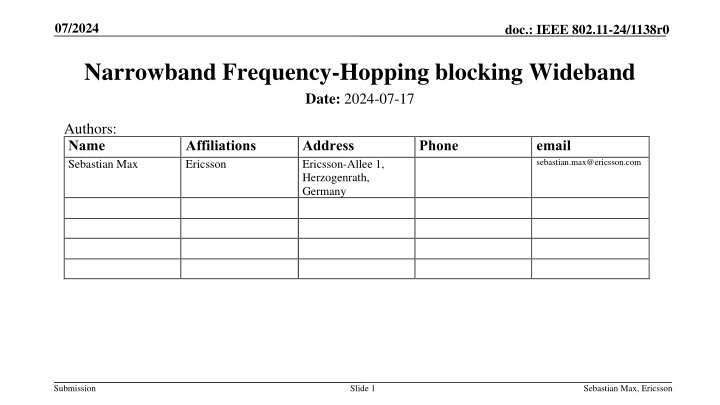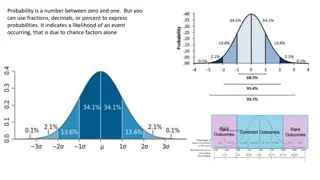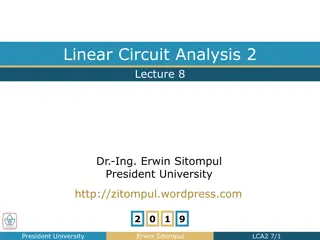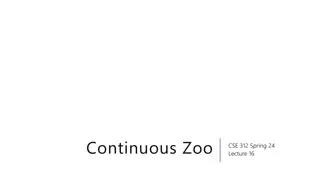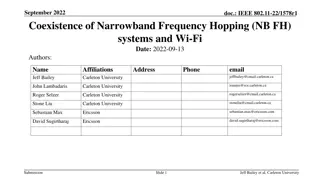Analyzing Blocking Probability in Wideband Links with Narrowband Frequency Hopping
This document delves into the analysis of the likelihood of wideband link obstructions resulting from multiple active narrowband frequency hopping (NBFH) links. A dynamic Energy Detection Threshold (EDT) approach is suggested for mitigation. The study also explores scenarios involving single and multiple NBFH links, highlighting the impact on wideband channel access. Factors affecting the blocking probability of wideband links, such as spectrum usage and the number of active links, are discussed in detail.
Download Presentation

Please find below an Image/Link to download the presentation.
The content on the website is provided AS IS for your information and personal use only. It may not be sold, licensed, or shared on other websites without obtaining consent from the author.If you encounter any issues during the download, it is possible that the publisher has removed the file from their server.
You are allowed to download the files provided on this website for personal or commercial use, subject to the condition that they are used lawfully. All files are the property of their respective owners.
The content on the website is provided AS IS for your information and personal use only. It may not be sold, licensed, or shared on other websites without obtaining consent from the author.
E N D
Presentation Transcript
07/2024 doc.: IEEE 802.11-24/1138r0 Narrowband Frequency-Hopping blocking Wideband Date: 2024-07-17 Authors: Name Sebastian Max Affiliations Ericsson Address Ericsson-Allee 1, Herzogenrath, Germany Phone email sebastian.max@ericsson.com Submission Slide 1 Sebastian Max, Ericsson
07/2024 doc.: IEEE 802.11-24/1138r0 Abstract We analyse the probability of a wideband link being blocked from the channel access by multiple active narrowband frequency hopping (NBFH) links due to continuously received energy. Then, a mitigation is proposed, based on a dynamic Energy Detection Threshold (EDT). Submission Slide 2 Sebastian Max, Ericsson
07/2024 doc.: IEEE 802.11-24/1138r0 Narrowband FH blocking Wideband f Single NBFH link: Transmissions are spread over the available spectrum Connection events are filled to some extend t Submission Slide 3 Sebastian Max, Ericsson
07/2024 doc.: IEEE 802.11-24/1138r0 Narrowband FH blocking Wideband f Wideband becomes active in one wideband channel NBFH detects energy via short listen- before-talk NBFH May quickly jump to another freq for the connection event Probability that NBFH starts in a wideband gap is low t Submission Slide 4 Sebastian Max, Ericsson
07/2024 doc.: IEEE 802.11-24/1138r0 Narrowband FH blocking Wideband f Multiple NBFH links: Wideband starts LBT, but has to defer Wideband continues to sense the channel it remains busy at all times wideband starts CCA t channel occupancy of lower wideband channel Submission Slide 5 Sebastian Max, Ericsson
07/2024 doc.: IEEE 802.11-24/1138r0 Narrowband FH blocking Wideband Blocking probability of the wideband depends on NBFH spectrum usage Spectrum / number of channels Number of active links Duty cycle Wideband spectrum usage Required portion of idle spectrum Submission Slide 6 Sebastian Max, Ericsson
07/2024 doc.: IEEE 802.11-24/1138r0 Experiment 20 m Narrow-Band Frequency Hopping 230 channels (approx. full lower 6 GHz spectrum) [n] links located in 20 m 20 m area Each link has a central & peripheral device Random distance 0.5 m ... 1.5 m n = 1 ... 50 [rate] B packet per user every 10ms Rate = 10 B ... 800 B Mapped to [load]: load 1 %...80 % Connection Interval 10ms, tx power 10 dBm One wideband transmitter attempts to access a [bw] MHz channel every [0 1] s to transmit one 1 B packet EDCA, access category best effort Located at (10 m, 10 m) KPI Wideband Channel access delay: time from packet arrival to start of transmission Here: 99-percentile 20 m Submission Slide 7 Sebastian Max, Ericsson
07/2024 doc.: IEEE 802.11-24/1138r0 Experiment Result Visualization Load parameter: [n] [load] n = 1 ... 50 load = 1 % ... 80 % 210 results Result per load: 99- percentile of channel access delay Plot contour lines for [1, 5, 10, 20, 50, 100, 200, 500, 1000] ms (interpolated) contour lines for 99-percentile [ms] 14 15 results 80 80 70 20 Load per NBFH Link [%] Load per NBFH Link [%] 10 60 60 5 20 50 10 40 40 5 10 30 5 5 20 20 1 10 1 1 0 1 0 10 20 30 40 50 10 20 30 40 50 Number of NBFH Links Number of NBFH Links Submission Slide 8 Sebastian Max, Ericsson
07/2024 doc.: IEEE 802.11-24/1138r0 Wideband Channel Access Delay [ms] 80 80 100 50 10 70 20 70 20 Load per NBFH Link [%] Load per NBFH Link [%] 10 60 60 5 20 50 5 50 50 20 10 10 40 20 5 40 10 10 30 30 5 5 10 5 20 5 20 1 5 1 10 20 MHz 40 MHz 10 1 1 1 1 1 10 20 30 40 50 10 20 30 40 50 Number of NBFH Links Number of NBFH Links 80 80 20 500 50 200 70 70 50 500 Load per NBFH Link [%] Load per NBFH Link [%] 10 100 200 60 60 20 1000 100 200 10 50 50 20 500 50 50 100 1000 5 200 40 40 50 10 5 20 100 500 20 30 30 200 50 10 100 10 5 20 50 20 20 10 5 10 20 5 80 MHz 160 MHz 10 10 5 10 5 1 5 1 1 10 20 30 40 50 10 20 30 40 50 Number of NBFH Links Number of NBFH Links Submission Slide 9 Sebastian Max, Ericsson
07/2024 doc.: IEEE 802.11-24/1138r0 Conclusion & Solution Options Wideband channel access may be delayed in the presence of high NBFH load. Solutions under discussion: 1.Do nothing 2.Limit the duty cycle To what value? If triggered dynamically, what is the trigger? 3.Require Adaptive Frequency Hopping (AFH) How to describe requirements, when to trigger? Permitted convergence time, false positive/negative triggers, sampling Requirements on re-allocating channels classified as bad 4.Wideband supports frequency-adaptive transmission bandwidth Dynamic Bandwidth / Fully flexible puncturing (see for example 11-24/603r2) Channel access delay is the same as for 20 MHz, but average bandwidth is higher No restriction on primary 20 MHz 5.Introduce Dynamic EDT for Wideband Submission Slide 10 Sebastian Max, Ericsson
07/2024 doc.: IEEE 802.11-24/1138r0 Interlude: Dynamic EDT for NBFH (from 11-24/0603r2) Bluetooth 0.05 100% FTP / Scenario A 100% FTP / Scenario B 50% FTP / Scenario A 50% FTP / Scenario B 0.04 Packet Delay [s] 0.03 0.02 0.01 0 0 1 2 3 4 5 6 Number of Bluetooth Links Bluetooth 0.05 100% FTP / Scenario A 100% FTP / Scenario B 50% FTP / Scenario A 50% FTP / Scenario B 0.04 Packet Delay [s] 0.03 0.02 0.01 0 0 1 2 3 4 5 6 Number of Bluetooth Links Mitigate impact to delay of NBFH in the presence of high duty-cycle Wideband Submission Slide 11 Sebastian Max, Ericsson
07/2024 doc.: IEEE 802.11-24/1138r0 Wideband with Static EDT f Multiple NBFH links: Wideband starts LBT, but has to defer Wideband continues to sense the channel it remains busy at all times wideband starts CCA t channel occupancy of lower wideband channel Prx busy EDT idle t Submission Slide 12 Sebastian Max, Ericsson
07/2024 doc.: IEEE 802.11-24/1138r0 Wideband with Dynamic EDT f Trigger: No idle channel detected for a significant duration Longer than a TXOP If triggered, EDT is slowly increased 1 dB/1 ms while channel remains busy EDT reset to default after successful transmission wideband starts CCA t channel occupancy of lower wideband channel Prx CCA reports idle, backoff starts fall back to default busy EDT idle t Trigger Submission Slide 13 Sebastian Max, Ericsson
07/2024 doc.: IEEE 802.11-24/1138r0 Results: Wideband uses 20 MHz [ms] Static EDT Dynamic EDT 80 80 20 70 70 20 Load per NBFH Link [%] Load per NBFH Link [%] 10 10 60 60 20 5 5 20 50 50 10 10 40 40 5 5 10 10 30 30 5 5 5 5 20 20 1 1 10 10 1 1 1 1 1 1 10 20 30 40 50 10 20 30 40 50 Number of NBFH Links Number of NBFH Links Submission Slide 14 Sebastian Max, Ericsson
07/2024 doc.: IEEE 802.11-24/1138r0 Results: Wideband uses 40 MHz [ms] Static EDT Dynamic EDT 80 80 100 50 10 10 20 70 70 20 Load per NBFH Link [%] Load per NBFH Link [%] 60 60 50 5 5 20 50 50 20 10 10 20 20 40 40 10 10 30 30 5 5 10 10 5 5 20 20 5 5 1 1 10 10 1 1 1 1 10 20 30 40 50 10 20 30 40 50 Number of NBFH Links Number of NBFH Links Submission Slide 15 Sebastian Max, Ericsson
07/2024 doc.: IEEE 802.11-24/1138r0 Results: Wideband uses 80 MHz [ms] Static EDT Dynamic EDT 80 80 20 200 70 70 50 500 Load per NBFH Link [%] Load per NBFH Link [%] 10 10 100 60 60 20 200 50 50 20 50 100 5 5 40 40 50 10 10 20 20 30 30 20 10 10 5 5 20 20 10 10 5 5 10 10 5 5 1 1 1 10 20 30 40 50 10 20 30 40 50 Number of NBFH Links Number of NBFH Links Submission Slide 16 Sebastian Max, Ericsson
07/2024 doc.: IEEE 802.11-24/1138r0 Results: Wideband uses 160 MHz [ms] Static EDT Dynamic EDT 80 80 500 50 70 70 Load per NBFH Link [%] Load per NBFH Link [%] 20 50 200 60 60 20 1000 100 50 10 10 50 50 500 50 1000 200 40 40 20 5 5 20 100 500 30 30 200 50 10 10 100 20 20 50 20 20 20 5 5 10 10 20 10 10 10 10 5 5 5 5 1 1 10 20 30 40 50 10 20 30 40 50 Number of NBFH Links Number of NBFH Links Submission Slide 17 Sebastian Max, Ericsson
07/2024 doc.: IEEE 802.11-24/1138r0 Conclusion EDT-boosting for Wideband mitigates the channel access delay increase in the presence of high duty-cycle NBFH links Can be combined with dynamic bandwidth selection to achieve optimum channel usage Dynamic EDT is also applicable to other high noise floor conditions Essentially introduces a time-limited floating noise floor Parameters to be discussed: Waiting time [here: 10 ms] EDT-boost after waiting time [here: linear 1 dB/1 ms] Maximum EDT-boost [here: none] Submission Slide 18 Sebastian Max, Ericsson
